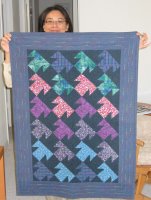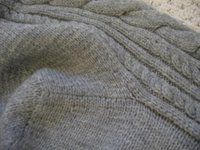 The holidays are upon us. Mark and I went down our list tonight over dinner. Notably, I will be making fewer gifts this year.
The holidays are upon us. Mark and I went down our list tonight over dinner. Notably, I will be making fewer gifts this year.I have mixed feelings about making things for others. Look at the quilt I am proudly holding at left. I made it in 1995. I was younger then and let myself be talked into giving it away to one of my husband's college friends as a wedding gift.
The bride apparently didn't like it as the groom was able to retrieve it from her attic after they divorced. He had promised to retrieve the quilt from the attic and mail it to me a decade ago, but he never got around to it. The groom was using it in his new loft, as a kind of shelf liner, burying it under a pile of books. This was not the fate I had hoped for. That quilt took weeks of planning and work. I probably spent about 40 hours on it in total. At my consulting rate, that is one expensive wedding quilt. My free time is doubly precious to me so, perhaps, I should multiply the rate by two. (Now I understand how the Pentagon can spend $800 on a hammer.)
I have no shame. I saw the quilt there last month and asked for it back. I am so happy to have "Flying Kimonos" back.
Click "Read more!" for more.
In 1995, I was having problems with vague pain and swelling. I didn't think it would last. I thought I had much more time and many more quilts left in me. I made quilts for most of my friends' first babies. I made a couple of wedding gift quilts. I even made 2 quilts for my husband's co-worker's babies because he asked me to. I had no idea that sewing would become more physically difficult for me over time.
When Iris was born, she didn't have a quilt. I wasn't able to sew her one. No one sent her one as, by then, they were busy with their own children. Friends sent lots of purchased gifts but I still feel sad that I didn't make a quilt and save it for her.
I think about the quilt that took me 30 hours and was given to someone I barely knew. When my husband's coworker next saw me, he thanked me for the "blanket". Years later, when his wife had started sewing seriously, she asked me how long it took me to make the quilt for her son. I estimated 30 hours. I guess that made her feel guilty. She sent us several boxes of kids hand-me-down toys and clothes.
Another time, I went to a recipient's house and saw that, despite the sleeve hand-stitched to the back of the quilt and the dowel I gave her, she had hung the quilt up by putting nails through the quilt at the two top corners. I always signed my quilts and packed them with care instructions. I was shocked at the treatment given that quilt. It had paper pieced 1" half square triangles. Though relatively small in size, it was not small in expenditure of time.
Is it any wonder that I have an affinity for the song, "God bless the child...that has his own"?
My favorite gift recipient was a Chinese graduate student whom I also barely knew (another of DH's coworkers). She said eloquently, "China is a poor country. If we want to show someone how much we care, we spend a lot of money. America is a rich country, but no one has enough time. If you want to show how much you care, you give them your time. I know how much this means." All 4 fellow grad students that worked on the quilt misted up right along with her.
Check out the gift knitting lists of cmeknit and yarnknita! I am glad that there are such generous people out there. I just don't feel up to it this year.
Icelandic yoke sweater update
I went to Slipt Stitch today at lunch and bought the soft green heather worsted of my dreams. I didn't see the yellow/orange of my dreams so the light butternut worsted from my stash will have to do.
And because I worry about everything
A nameless catalog came to our house today with "It is not too late" and "Order as late as December 21" emblazoned across the cover. Read Procrastination and Climate Change for why that really bothers me.




























